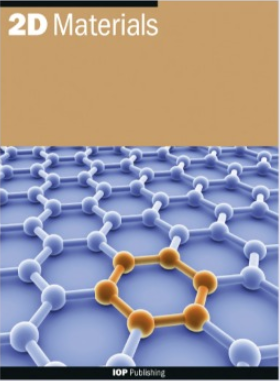石墨剥离成涡流石墨烯
IF 4.5
3区 材料科学
Q2 MATERIALS SCIENCE, MULTIDISCIPLINARY
引用次数: 0
摘要
在此,我们利用等离子喷涂这一工业友好型技术,直接从石墨中以较高的生产率(10 克/小时)剥离出具有洁净界面的高质量涡流石墨烯。(002) X 射线衍射峰的减少和透明的扫描电子显微镜 (SEM) 图像用于表征剥离。利用原子力显微镜(AFM)测量剥离石墨烯层的厚度。根据 1800 厘米-1 和 2300 厘米-1 之间出现的三个拉曼组合带(TS1、TS2 和 TS3),可以确定石墨烯的涡旋性质(扭曲)。利用选区电子衍射(SAED)精确测量了层间的扭曲,并通过利用高分辨率透射电子显微镜(HR-TEM)观察摩尔纹(moiré pattern)确认了湍流性质。所制备的湍流石墨烯的扭转角变化很大(2⁰-30⁰),并具有可见的摩尔纹。摩尔纹和 SAED 证实了单层石墨烯的高结晶质量和洁净界面。随后,我们证明了剥离石墨烯产生扭曲的机理,这为生产具有清洁界面的高质量涡流石墨烯开辟了道路。本文章由计算机程序翻译,如有差异,请以英文原文为准。
Exfoliation of graphite to turbostratic graphene
Here, we exfoliated high-quality turbostratic graphene with a clean interface at a high production rate (10 g/h) directly from graphite using an industrial-friendly technique i.e., plasma spraying, catching note of its growing global interest. The reduction of the (002) X-ray diffraction peak and the transparent scanning electron microscope (SEM) image are used to characterize the exfoliation. The thickness of exfoliated graphene layers is measured using an atomic force microscope (AFM). Turbostratic nature (twist) in graphene is identified based on the appearance of three Raman combination bands (TS1, TS2, and TS3) between 1800 cm-1 and 2300 cm-1. The twist between the layers is precisely measured using selected area electron diffraction (SAED), and the turbostratic nature is confirmed by observing a moiré pattern utilizing a high-resolution transmission electron microscope (HR-TEM). The produced turbostratic graphene exhibited large variability in twist angles (2⁰-30⁰) with a visible moiré pattern. The high crystalline quality and clean interface between single layers of graphene were confirmed by the moiré pattern and SAED. Later, we demonstrated the mechanism underlying the twist in our exfoliated graphene, which could open the way for the production of high-quality turbostratic graphene with clean interfaces.
求助全文
通过发布文献求助,成功后即可免费获取论文全文。
去求助
来源期刊

2D Materials
MATERIALS SCIENCE, MULTIDISCIPLINARY-
CiteScore
10.70
自引率
5.50%
发文量
138
审稿时长
1.5 months
期刊介绍:
2D Materials is a multidisciplinary, electronic-only journal devoted to publishing fundamental and applied research of the highest quality and impact covering all aspects of graphene and related two-dimensional materials.
 求助内容:
求助内容: 应助结果提醒方式:
应助结果提醒方式:


